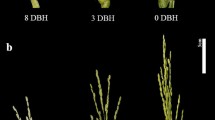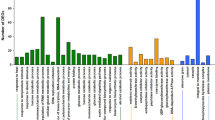Abstract
Microarray analysis of mRNA populations is routinely conducted with total RNA. However, such analyses would probably represent the translated genome (proteome) more accurately if conducted with polysomal RNA. An accurate assessment of the proteome is essential where microarray analysis is used to produce molecular markers for breeding programs. In order to determine whether significant variation occurs between these two RNA populations, the relative abundance of transcripts was analyzed in barley aleurones of intact 3.5 day old germinated seedlings, comparing total and polysomal RNAs. A total of 13,744 transcripts was detected among both populations. Of these, 714 were detected only in total RNA, and 1,541 were detected only in polysomal RNA. A surprising number of transcripts detected in both populations (6,312 gene calls or 46% of the compared transcripts) differed significantly between populations. Almost half of these (2,987) were more abundant by at least two-fold, depending on the RNA source, and expression was often biased toward specific functional classes of genes. Transcripts encoding hydrolytic enzymes for the mobilization of stored seed macromolecules were more highly represented in total RNA, rather than polysomal RNA. These included proteinases, nucleases and carbohydrases. Genes for ribonucleoprotein complexes, nucleic acid binding and components of ribosomes were more abundant in polysomal RNA. Among genes with signal intensities of 1,000 or more, hydrolases were greatly over-represented in total RNA, whereas ubiquitin, histone and kinase related genes were mainly represented in polysomal RNA.



Similar content being viewed by others
References
Bamforth CW, Barclay AHP (1993) Malting technology and the uses of malt. In: MacGregor AW, Bhatty RS (eds) Barley: chemistry and technology. American Assoc. of Cereal Chemists, Inc., St. Paul, MN
Bérengè P-B, Boulmé F, Beug H, Müllner EW, Garcia-Sanz JA (2001) Translational control: bridging the gap between genomics and proteomics? Trends Biochem Sci 26:225–229
Berger SL, Birkenmeier CS (1979) Inhibition of intractable nucleases with ribonucleoside-vanadyl complexes: isolation of messenger ribonucleic acid from resting lymphocytes. Biochemistry 18:5143–5149
Bethke PC, Hwang Y-S, Zhu T, Jones RL (2005) Global patterns of gene expression in the aleurone of wild-type and dwarf1 mutant rice. Plant Physiol 140:484–498
Boddu J, Cho S, Kruger WM, Muehlbauer GJ (2006) Transcriptome analysis of the barley-Fusarium graminearum interaction. Mol Plant Microbe Int 19:407–417
Briggs DE (1978) Barley. Chapman and Hall, London, pp 208–215
Caldo RA, Nettleton D, Wise RP (2004) Interaction-dependent gene expression in Mla-specified response to barley powdery mildew. Plant Cell 16:2514–2528
Carrari F, Baxter C, Usadel B, Urbanczyk-Wochniac E, Zanor AN, Nikiforova V, Centero D, Ratzka A, Pauly M et al (2006) Integrated analysis of metabolite and transcript levels reveals the metabolic shifts that underlie tomato fruit development and highlight regulatory aspects of metabolic network behavior. Plant Physiol 142:1380–1396
Chandler PM, Jacobsen JV (1991) Primer extension studies on α-amylase mRNAs in barley aleurone. II. Hormonal regulation of expression. Plant Mol Biol 16:637–645
Chen K, An Y-QC (2006) Transcriptional responses to gibberellin and abscisic acid in barley aleurone. J Integr Plant Biol 48:591–612
Close TJ, Wanamaker SL, Caldo RA, Turner SM, Ashlock DA, Dickerson JA, Wing RA, Muehlbauer GJ, Kleinhofs A, Wise RP (2004) A new resource for cereal genomics: 22K barley gene chip comes of age. Plant Physiol 134:960–968
Gygi SP, Rochon Y, Franza BR, Aebersold R (1999) Correlation between protein and mRNA abundance in yeast. Mol Cell Biol 19:1720–1730
Hayes PM, Castro A, Marquez-Cedillo, Corey A, Henson C, Jones B, Kling J, Mather D, Matus I, Rossi C, Sato K (2003) Genetic diversity for quantitatively inherited agronomic and malting quality traits. In: Roland von Bothmer et al. (eds) Diversity in barley (Hordeum vulgare). Elsevier Science B.V
Pradet-Balade B, Boulmé F, Beug H, Müllner EW, Garcia-Sanz JA (2001) Translational control: bridging the gap between genomics and proteomics? Trends Biochem Sci 26:225–229
Rogers JC (1985) Two barley α-amylase gene families are regulated differently in aleurone cells. J Biol Chem 260:3731–3738
Shen L, Gong J, Caldo RA, Nettleton D, Cook D, Wise RP, Dickerson JA (2005) BarleyBase-an expression profiling database for plant genomics. Nucleic Acids Res 33: Database issue
Skadsen RW (1993) Aleurones from a barley with low α-amylase activity become highly responsive to gibberellin when detached from the starchy endosperm. Plant Physiol 102:195–203
Skadsen RW, Scandalios JG (1986) Evidence for processing of maize catalase 2 and purification of its messenger RNA aided by translation of antibody-bound polysomes. Biochemistry 25:2027–2032
Skadsen RW, Tibbot BK (1994) Temporal expression patterns of Alpha-amylase isozymal genes in polysomal and total RNAs of germinating barleys. J Cereal Sci 19:199–208
Skadsen RW, Schulze-Lefert P, Herbst JM (1995) Molecular cloning, characterization and expression analysis of two catalase isozymal genes in barley. Plant Mol. Biol 29:1005–1014
Svensson JT, Crosatti C, Campoli C, Bassi R, Stanca AM, Close TJ, Cattivelli L (2006) Transcriptome analysis of cold acclimation in barley Albina and Xantha mutants. Plant Physiol 141:257–270
Tusher VG, Tibshirani R, Chu G (2001) Significance analysis of microarrays applied to the ionizing radiation response. Proc Natl Acad Sci USA 98:5116–5121
Acknowledgements
The pM/C clone was generously provided by John Rogers (Washington State Univ.). The 18S barley rRNA was cloned in our lab by John Herbst. This material is based upon work supported by the U.S. Department of Agriculture. Any opinions, findings, conclusions, or recommendations expressed in this publication are those of the author(s) and do not necessarily reflect the view of the U.S. Department of Agriculture. Mention of trade names or commercial products in this article is solely for the purpose of providing specific information and does not imply recommendation or endorsement by the U.S. Dept. of Agriculture.
Author information
Authors and Affiliations
Corresponding author
Rights and permissions
About this article
Cite this article
Skadsen, R.W., Jing, P. Transcriptome profile of barley aleurone differs between total and polysomal RNAs: implications for proteome modeling. Mol Breeding 21, 261–269 (2008). https://doi.org/10.1007/s11032-007-9126-6
Received:
Accepted:
Published:
Issue Date:
DOI: https://doi.org/10.1007/s11032-007-9126-6




